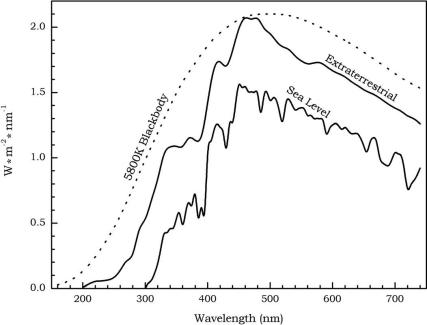Field Instruments: Use and Application
Almost all light in the natural environment originates from the Sun. Its spectral distribution is similar to that of an efficient radiant surface known as a blackbody at a temperature of 5800 K, which ranges from 100 to 9000 nm, (Figure 5.10).

FIGURE 5.10 Spectral irradiance of the incoming sun radiation outside the atmosphere and at sea level compared with that of a perfect blackbody at 5800 K
In passing through the atmosphere, a small portion of this light is absorbed, and some is scattered. Short wavelengths are strongly scattered, and ozone absorption effectively eliminates wavelengths less than 300 nm. At longer wavelengths, water vapor, carbon dioxide, and oxygen absorb light significantly at particular wavelengths, producing sharp dips in the spectrum. At still-longer wavelengths, beyond 4000 nm, all objects in the environment become significant sources of radiations, depending on their temperature, and surpass sunlight in intensity. These characteristics of the environment restrict the range of electromagnetic radiation. Solar radiant energy that reaches the surface of the earth has a spectral range from about 300 nm (ultraviolet) to about 4000 nm (infrared). Photosynthetically active radiation (PAR) occurs between approximately 400 and 700 nm and is less than 50% of the total energy impinging on the Earth’s surface.
Before describing the detectors used in the field application, a short lexicon of the terms and the conversion units on light measurements would be very useful because of the plethora of confusing terminology and units.





